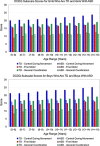Is Motor Impairment in Autism Spectrum Disorder Distinct From Developmental Coordination Disorder? A Report From the SPARK Study
- PMID: 32154876
- PMCID: PMC7297441
- DOI: 10.1093/ptj/pzz190
Is Motor Impairment in Autism Spectrum Disorder Distinct From Developmental Coordination Disorder? A Report From the SPARK Study
Abstract
Background: Motor impairments are pervasive in Autism Spectrum Disorder (ASD); however, children with ASD rarely receive a dual diagnosis of Developmental Coordination Disorder (DCD). The Simons Foundation SPARK study engaged families affected by ASD through an online study.
Objectives: The DCD parent questionnaire (DCDQ) was used to assess the prevalence of a risk for motor impairment or DCD in children with ASD between 5 and 15 years of age.
Design: This study utilizes parent reports from a large database of children with ASD.
Methods: A total of 16,705 parents of children with ASD completed the DCDQ. We obtained our final SPARK dataset (n = 11,814) after filtering out invalid data, using stronger cut-offs to confirm ASD traits, and excluding children with general neuromotor impairments/intellectual delays. We compared DCDQ total and subscale scores from the SPARK dataset with published norms for each age between 5 and 15 years.
Results: The proportion of children with ASD at risk for a motor impairment was very high at 86.9%. Children with ASD did not outgrow their motor impairments and continued to present with a risk for DCD even into adolescence. Yet, only 31.6% of children were receiving physical therapy services.
Limitations: Our analysis of a large database of parent-reported outcomes using the DCDQ did not involve follow-up clinical assessments.
Conclusions: Using a large sample of children with ASD, this study shows that a risk for motor impairment or DCD was present in most children with ASD and persists into adolescence; however, only a small proportion of children with ASD were receiving physical therapist interventions. A diagnosis of ASD must trigger motor screening, evaluations, and appropriate interventions by physical and occupational therapists to address the functional impairments of children with ASD while also positively impacting their social communication, cognition, and behavior. Using valid motor measures, future research must determine if motor impairment is a fundamental feature of ASD.
Keywords: Autism; Children; DCD; Diagnosis; Motor; Treatment.
© 2020 American Physical Therapy Association.
Figures




References
-
- Buescher A, Cidav Z, Knapp M, Mandell DS. Costs of autism spectrum disorders in the United Kingdom and the United States. JAMA Pediatr. 2014;168:721–728. - PubMed
-
- Leigh JP, Du J. Brief report: forecasting the economic burden of autism in 2015 and 2025 in the United States. J Autism Dev Disord. 2015;45:4135–4139. - PubMed
-
- American Psychiatric Association Diagnostic and Statistical Manual of Mental Disorders. 5th ed. Arlington, VA, USA: American Psychiatric Association; 2013.
-
- Bhat A, Landa R, Galloway JC. Current perspectives on motor functioning in infants, children, and adults with autism spectrum disorders. Phys Ther. 2011;91:1116–1129. - PubMed

